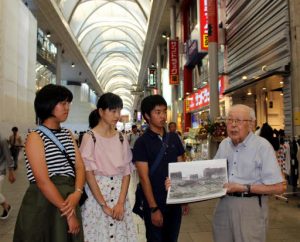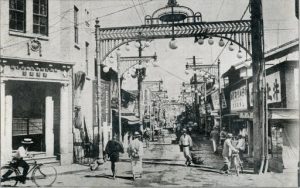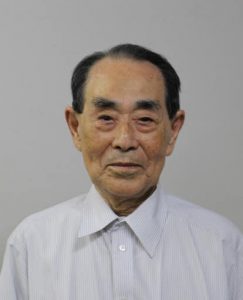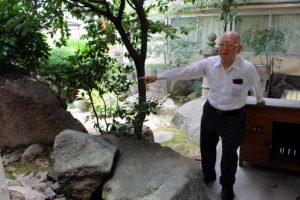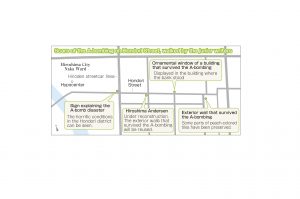Peace Seeds: Teens in Hiroshima Sow Seeds of Peace (Part 60)
Sep. 20, 2018
Part 60: Hondori shopping district and the atomic bombing
The Hondori shopping district in the city of Hiroshima is the largest shopping district in the Chugoku and Shikoku regions, and about 100,000 people move through this area each day. It is said that the district was also a bustling place before the war with around 160 shops prior to the atomic bombing. Though the area was annihilated in the A-bomb attack, the survivors sought to reconstruct this district soon after the war ended.
Seventy-three years have passed since the atomic bombing and it is now hard to imagine the city in a state of devastation. The junior writers of the Chugoku Shimbun gathered information about the damage wrought in the Hondori shopping district and the process of its reconstruction, and we walked around the area to observe the lingering scars left behind by the bombing. We encourage you to walk these streets, too, and reflect on what occurred as a result of this attack as well as those who made efforts to bring the district back to life.
Shopping district burns to the ground
We visited Hiroshi Okumoto, 88, whose parents once ran a hardware shop, to ask about what happened to the Hondori shopping district on August 6, 1945. Back then, Mr. Okumoto was a third-year student at Shudo Junior High School. He was working as a mobilized student about 4.1 kilometers from the hypocenter at the time the bomb exploded. He tried to return to his home on Hondori Street, but fire blocked his way. He was then able to reach his street on the morning of August 7.
Concrete buildings remained, but shops had burned down. He heard no sounds and there was no sign of life. Several people were seated in the bank, but he wasn’t sure whether they were dead or alive.
Mr. Okumoto wanted to continue on to his home, which had completely burned to the ground, but the area was still in flames. He tore off a page from his notepad and wrote on it “Hiroshi has survived.” Then he placed it on the ground and went to where his grandmother had evacuated earlier.
Mr. Okumoto believed that the other members of his family were still alive somewhere and he continued to search for them without shedding any tears. His mother had escaped from their storehouse, and he was able to reunite with her around August 9. His mother, who had only scratches on her back, became bedridden because of the effects of her exposure to the bomb’s radiation and she passed away on August 14.
His father, who was minding their shop at the time of the bombing, was carried to Kanawajima Island (now part of Minami Ward) and died on August 12 after being brought to Kuba National School (today’s Kuba Elementary School in the city of Otake).
Mr. Okumoto lost his two sisters and two brothers in the atomic bombing. After the war, he lived with relatives in Shikoku and returned to Hiroshima in 1949. He worked for a hardware wholesaler to take over the family business but he thought that a hardware shop did not suit the time, and instead he opened a men’s clothing store in 1962. Because he feels such a strong attachment to Hondori Street, he has continued to live there since he closed the shop in 2001.
Mr. Okumoto talked to us on Hondori Street while showing us photos that were taken in the aftermath of the atomic bombing. We won’t forget the fact that many people worked to revive this district from the ashes of the bombing. (Honoka Ikeda, 18, and Ryoma Iwata, 15)
Dressed-up people and beautiful streetlamps
We visited the office of the Hiroshima Hondori shopping center promotion association to listen to Hiroshi Noda, 87, former head of the association, who is knowledgeable about the state of the district before the atomic bombing.
Mr. Noda attended Fukuromachi National School (now Fukuromachi Elementary School) near Hondori Street. He said that there had been many specialty shops, and that stalls selling toys and other things were open each evening prior to the A-bomb attack. People coming and going wore their best kimonos. Looking back on that time, he said he had nostalgic memories of his parents buying him various things, such as a pair of binoculars and books.
The lily-of-the-valley lamps that lit the streets were very beautiful, but they were donated to the military to be used as scrap metal for the war effort. He remembers workers roughly tearing down the lamps, shouting, “Watch out! Get out of here!” He said that he felt lonely and sad though he was only a child then.
The Nodas once ran a clothing shop on Hondori Street. Mr. Noda hopes that the Hondori district will always be bustling with people. (Miyuu Okada, 17)
Reconstructing the district and reopening the shop
We also listened to Kaiso Akamatsu, 90, the chairperson of Akamatsu pharmacy, who reopened the pharmacy on Hondori Street after the atomic bombing and still runs it today.
At the time of the bombing, Mr. Akamatsu was attending a school in Gifu Prefecture to become a pharmacist. When he learned that Hiroshima had been attacked, he returned right away to the devastated city. Turning over roof tiles at the site where his pharmacy and home had stood, he found his parents’ remains. Afterwards, he remembered his father saying, “In case something happens, dig here.” He then dug in the garden and found some cash and a sheet of paper that noted where the medicines could be found. He was glad to have made this helpful discovery.
Hondori Street, now revived after the bombing turned it into burnt ruins, runs behind Mr. Akamatsu’s pharmacy. He showed us a garden rock on his grounds, a remnant of that time.
After returning from the front lines, his eldest brother constructed a shack and reopened the pharmacy. Mr. Akamatsu worked hard alongside him, maintaining a positive spirit. In 1952, a festival began to be held along Hondori Street, which included a parade. When Mr. Akamatsu saw the shopping district teeming with people, he felt that the area had finally come back to life. (Yoshiko Hirata, 17, and Riho Kito, 17)
Spotting the scars of the atomic bombing
Starting from the sign that notes the damage to Hondori Street caused by the atomic bombing, we took a walk and observed the lingering scars of the A-bomb attack. Walking east, we came to the building of the Andersen bakery and restaurant, which survived the bombing and is now undergoing renovations. The older wing of the building will be rebuilt while making use of the exterior walls that still stand from that time.
As we went on, we saw a “silent witness” in another building, an ornamental window in the former Hondori branch of the Yamaguchi Bank. Most surprising of all was what we spotted at Parco, a department store that houses a range of fashionable shops. Portions of an exterior wall of the Kirin Beer Hall, which survived the bombing, have been embedded in Parco’s building, these tiled parts appearing blackish and chipped. I have passed by the building many times, but I had never noticed this before. (Miki Meguro, 15)
What is Peace Seeds?
Peace Seeds are the seeds of smiles which can be spread around the world by thinking about peace and the preciousness of life from various viewpoints. To fill this world with flowering smiles, the junior writers, comprised of junior high school and high school students, choose themes, gather information, and write articles.
(Originally published on September 20, 2018)
The Hondori shopping district in the city of Hiroshima is the largest shopping district in the Chugoku and Shikoku regions, and about 100,000 people move through this area each day. It is said that the district was also a bustling place before the war with around 160 shops prior to the atomic bombing. Though the area was annihilated in the A-bomb attack, the survivors sought to reconstruct this district soon after the war ended.
Seventy-three years have passed since the atomic bombing and it is now hard to imagine the city in a state of devastation. The junior writers of the Chugoku Shimbun gathered information about the damage wrought in the Hondori shopping district and the process of its reconstruction, and we walked around the area to observe the lingering scars left behind by the bombing. We encourage you to walk these streets, too, and reflect on what occurred as a result of this attack as well as those who made efforts to bring the district back to life.
Shopping district burns to the ground
We visited Hiroshi Okumoto, 88, whose parents once ran a hardware shop, to ask about what happened to the Hondori shopping district on August 6, 1945. Back then, Mr. Okumoto was a third-year student at Shudo Junior High School. He was working as a mobilized student about 4.1 kilometers from the hypocenter at the time the bomb exploded. He tried to return to his home on Hondori Street, but fire blocked his way. He was then able to reach his street on the morning of August 7.
Concrete buildings remained, but shops had burned down. He heard no sounds and there was no sign of life. Several people were seated in the bank, but he wasn’t sure whether they were dead or alive.
Mr. Okumoto wanted to continue on to his home, which had completely burned to the ground, but the area was still in flames. He tore off a page from his notepad and wrote on it “Hiroshi has survived.” Then he placed it on the ground and went to where his grandmother had evacuated earlier.
Mr. Okumoto believed that the other members of his family were still alive somewhere and he continued to search for them without shedding any tears. His mother had escaped from their storehouse, and he was able to reunite with her around August 9. His mother, who had only scratches on her back, became bedridden because of the effects of her exposure to the bomb’s radiation and she passed away on August 14.
His father, who was minding their shop at the time of the bombing, was carried to Kanawajima Island (now part of Minami Ward) and died on August 12 after being brought to Kuba National School (today’s Kuba Elementary School in the city of Otake).
Mr. Okumoto lost his two sisters and two brothers in the atomic bombing. After the war, he lived with relatives in Shikoku and returned to Hiroshima in 1949. He worked for a hardware wholesaler to take over the family business but he thought that a hardware shop did not suit the time, and instead he opened a men’s clothing store in 1962. Because he feels such a strong attachment to Hondori Street, he has continued to live there since he closed the shop in 2001.
Mr. Okumoto talked to us on Hondori Street while showing us photos that were taken in the aftermath of the atomic bombing. We won’t forget the fact that many people worked to revive this district from the ashes of the bombing. (Honoka Ikeda, 18, and Ryoma Iwata, 15)
Dressed-up people and beautiful streetlamps
We visited the office of the Hiroshima Hondori shopping center promotion association to listen to Hiroshi Noda, 87, former head of the association, who is knowledgeable about the state of the district before the atomic bombing.
Mr. Noda attended Fukuromachi National School (now Fukuromachi Elementary School) near Hondori Street. He said that there had been many specialty shops, and that stalls selling toys and other things were open each evening prior to the A-bomb attack. People coming and going wore their best kimonos. Looking back on that time, he said he had nostalgic memories of his parents buying him various things, such as a pair of binoculars and books.
The lily-of-the-valley lamps that lit the streets were very beautiful, but they were donated to the military to be used as scrap metal for the war effort. He remembers workers roughly tearing down the lamps, shouting, “Watch out! Get out of here!” He said that he felt lonely and sad though he was only a child then.
The Nodas once ran a clothing shop on Hondori Street. Mr. Noda hopes that the Hondori district will always be bustling with people. (Miyuu Okada, 17)
Reconstructing the district and reopening the shop
We also listened to Kaiso Akamatsu, 90, the chairperson of Akamatsu pharmacy, who reopened the pharmacy on Hondori Street after the atomic bombing and still runs it today.
At the time of the bombing, Mr. Akamatsu was attending a school in Gifu Prefecture to become a pharmacist. When he learned that Hiroshima had been attacked, he returned right away to the devastated city. Turning over roof tiles at the site where his pharmacy and home had stood, he found his parents’ remains. Afterwards, he remembered his father saying, “In case something happens, dig here.” He then dug in the garden and found some cash and a sheet of paper that noted where the medicines could be found. He was glad to have made this helpful discovery.
Hondori Street, now revived after the bombing turned it into burnt ruins, runs behind Mr. Akamatsu’s pharmacy. He showed us a garden rock on his grounds, a remnant of that time.
After returning from the front lines, his eldest brother constructed a shack and reopened the pharmacy. Mr. Akamatsu worked hard alongside him, maintaining a positive spirit. In 1952, a festival began to be held along Hondori Street, which included a parade. When Mr. Akamatsu saw the shopping district teeming with people, he felt that the area had finally come back to life. (Yoshiko Hirata, 17, and Riho Kito, 17)
Spotting the scars of the atomic bombing
Starting from the sign that notes the damage to Hondori Street caused by the atomic bombing, we took a walk and observed the lingering scars of the A-bomb attack. Walking east, we came to the building of the Andersen bakery and restaurant, which survived the bombing and is now undergoing renovations. The older wing of the building will be rebuilt while making use of the exterior walls that still stand from that time.
As we went on, we saw a “silent witness” in another building, an ornamental window in the former Hondori branch of the Yamaguchi Bank. Most surprising of all was what we spotted at Parco, a department store that houses a range of fashionable shops. Portions of an exterior wall of the Kirin Beer Hall, which survived the bombing, have been embedded in Parco’s building, these tiled parts appearing blackish and chipped. I have passed by the building many times, but I had never noticed this before. (Miki Meguro, 15)
What is Peace Seeds?
Peace Seeds are the seeds of smiles which can be spread around the world by thinking about peace and the preciousness of life from various viewpoints. To fill this world with flowering smiles, the junior writers, comprised of junior high school and high school students, choose themes, gather information, and write articles.
(Originally published on September 20, 2018)

